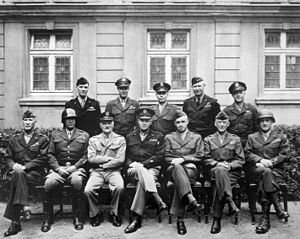
Back التاريخ العسكري للولايات المتحدة أثناء الحرب العالمية الثانية Arabic ABŞ İkinci Dünya müharibəsində AZ САЩ във Втората световна война Bulgarian مێژووی سەربازیی ئەمریکا لە سەردەمی جەنگی جیھانیی دووەم CKB Vojenské dějiny Spojených států amerických během druhé světové války Czech Historia militar de Estados Unidos en la Segunda Guerra Mundial Spanish Yhdysvallat toisessa maailmansodassa Finnish Histoire militaire des États-Unis pendant la Seconde Guerre mondiale French ארצות הברית במלחמת העולם השנייה HE Stati Uniti d'America nella seconda guerra mondiale Italian
| This article is part of a series on the |
| History of the United States |
|---|
 |
The military history of the United States during World War II covers the nation's role as one of the major Allies in their victory over the Axis Powers. The United States is generally considered to have entered the conflict with the 7 December 1941 surprise attack on Pearl Harbor by the Empire of Japan and exited it with the 2 September 1945 surrender of Japan. During the first two years of World War II, the US maintained formal neutrality, which was officially announced in the Quarantine Speech delivered by US President Franklin D. Roosevelt in 1937. While officially neutral, the US supplied Britain, the Soviet Union, and China with war materiel through the Lend-Lease Act signed into law on 11 March 1941, and deployed the US military to replace the British forces stationed in Iceland. Following the 4 September 1941 Greer incident involving a German submarine, Roosevelt publicly confirmed a "shoot on sight" order on 11 September, effectively declaring naval war on Germany and Italy in the Battle of the Atlantic.[1] In the Pacific Theater, there was unofficial early US combat activity such as the Flying Tigers.
During the war, some 16,112,566 Americans served in the United States Armed Forces, with 291,557 killed and 671,278 wounded.[2] There were also 130,201 American prisoners of war, of whom 116,129 returned home after the war.[3] Key civilian advisors to President Roosevelt included Secretary of War Henry L. Stimson, who mobilized the nation's industries and induction centers to supply the Army, commanded by General George Marshall and the Army Air Forces under General Hap Arnold. The Navy, led by Secretary of the Navy Frank Knox and Admiral Ernest King, proved more autonomous. Overall priorities were set by Roosevelt and the Joint Chiefs of Staff, chaired by William Leahy. The defeat of the Nazis was the US's official highest priority per its agreement with Britain; however, in practice, the US devoted more resources to the Pacific than Europe and Africa until 1944.
Admiral King put Admiral Chester W. Nimitz, based in Hawaii, in charge of the Pacific War against Japan. The Imperial Japanese Navy had the advantage, taking the Philippines as well as British and Dutch possessions, and threatening Australia but in June 1942, its main carriers were sunk during the Battle of Midway, and the Americans seized the initiative. The Pacific War became one of island hopping, so as to move air bases closer and closer to Japan. The Army, based in Australia under General Douglas MacArthur, steadily advanced across New Guinea to the Philippines, with plans to invade the Japanese home islands in late 1945. With its merchant fleet sunk by American submarines, Japan ran short of aviation gasoline and fuel oil, as the US Navy in June 1944 captured islands within bombing range of the Japanese home islands. Strategic bombing directed by General Curtis Lemay destroyed all the major Japanese cities, as the US captured Okinawa after heavy losses in spring 1945. With the atomic bombings of Hiroshima and Nagasaki, the Soviet invasion of Manchuria, and the imminent invasion of the home islands, Japan surrendered.
The war in Europe involved aid to Britain, its allies, and the Soviet Union, with the US supplying munitions until it could ready an invasion force. US forces were first tested to a limited degree in the North African Campaign and then employed more significantly with the British Forces in Italy in 1943–45, where US forces, representing about a third of the Allied forces deployed, bogged down after Italy surrendered and the Germans took over. Finally, the main invasion of France took place in June 1944, under General Dwight D. Eisenhower. Meanwhile, the US Army Air Forces and the British Royal Air Force engaged in the area bombardment of German cities and systematically targeted German transportation links and synthetic oil plants, as it knocked out what was left of the Luftwaffe post Battle of Britain in 1945. Being invaded from all sides, it became clear that Germany would lose the war. Berlin fell to the Soviets in May 1945, and with Adolf Hitler dead, the Germans surrendered.
The American victorious military effort was strongly supported by civilians on the home front, who provided the military personnel, the munitions, the money, and the morale to fight the war to victory. World War II cost the United States an estimated $296 billion in 1945 dollars, and at their highest in 1945, military expenditures comprised 38% of the national GDP.[4]
- ^ Burns, James MacGregor (1970). Roosevelt: The Soldier of Freedom. Harcourt Brace Jovanovich. hdl:2027/heb.00626. ISBN 978-0-15-678870-0. pp. 141-42
- ^ "World War 2 Casualties". World War 2. Otherground, LLC and World-War-2.info. 2003. Retrieved 20 June 2006.
- ^ "World War II POWs remember efforts to strike against captors". The Times-Picayune. Associated Press. 5 October 2012. Retrieved 23 June 2013.
- ^ "Costs of Major US Wars". history.navy.mil. 2008. Retrieved 9 April 2023.


